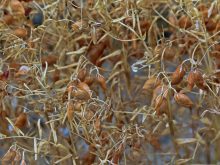SASKATOON — Turkey’s lentil crop appears to have avoided much drought damage so far this year.
Tuba Memis, import/export manager of Memisoglu, a Turkish pulse processing firm, estimates that red lentil planting was up 10 to 15 per cent.
The crop is planted in the November through January period and harvested in June.
Read Also

Russian wheat exports start to pick up the pace
Russia has had a slow start for its 2025-26 wheat export program, but the pace is starting to pick up and that is a bearish factor for prices.
Almost the entire crop is grown in the southeastern part of the country, where it was dry in October, November and December.
December rainfall was 53 percent below normal. It was also very dry in January.
“So, plants were in stress,” Memis said in an email.
However, the rain finally came in February, helping to reverse the fortunes of the crop.
“There was enough rain for red lentil plants, so the plants have recovered,” she said.
“In order to get good yields, we need rains in April and May also.”
If the rain delivers, production could be 10 to 15 per cent higher than last year’s crop of 405,000 tonnes, she said.
Mehmet Sonmez, a trader with Armada Foods, recently told the Global Pulse Confederation (GPC) that the February rain came at precisely the right time.
“We’ve got a much more favourable outlook for lentils now,” he said.
“Now things look more normal.”
India also has a good crop on the way. The government is forecasting 1.82 million tonnes of lentil production, well above the previous five-year average of 1.44 million tonnes.
In response, the Indian government has decided to impose an import duty of 11 per cent on the crop.
Pulse Canada president Greg Cherewyk said that is a significant increase from the zero per cent duty that had been in place, but it is still “manageable.”
Stat Publishing reports that the India Pulses and Grains Association was anticipating duties in the range of 25 to 30 per cent.
There are reports that India may be willing to offer “preferential import status” to U.S. lentils to soften the blow of the U.S. retaliatory duties that are coming on April 2, according to Stat.
The Australian Bureau of Agricultural and Resource Economics and Sciences estimates production at 1.16 million tonnes in that important export market, down from 1.57 million tonnes the previous year.
Turkey is both a major importer and re-exporter of lentils.
Memis said the country purchased 364,000 tonnes of the crop during the first 10 months of the 2023-24 campaign and exported 408,000 tonnes.
Canada was the top supplier, accounting for about half of those imports. Kazakhstan and Russia were also major contributors.
Iraq, Sudan and Algeria accounted for 58 per cent of Turkey’s exports during that period.
Sonmez said there has been an “absolute disappearance” in demand so far in 2024-25 as high interest rates and ample supplies have resulted in flat or bearish prices, resulting in hand-to-mouth purchasing.
















